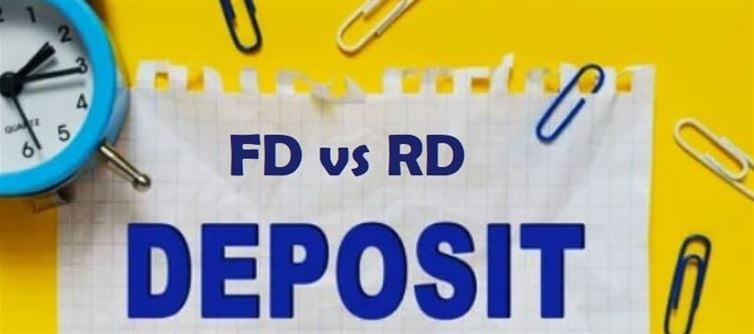
When it comes to safeguarding your hard-earned money, Fixed Deposits (FDs) and Recurring Deposits (RDs) are two of the most popular and safest investment options. They both offer guaranteed returns, but which one is right for you? In this article, we'll explore the key differences between these two investment vehicles and help you decide which one best suits your financial goals.
1. What Are Fixed Deposits (FDs)? – A Secure Investment Option
A Fixed Deposit (FD) is a traditional investment scheme offered by banks and financial institutions. Here, you deposit a lump sum amount for a fixed tenure, ranging from a few months to several years, and earn interest at a predetermined rate.
Key Features:
Fixed interest rate: You earn interest at the rate set when you open the FD.
Tenure flexibility: Typically ranges from 7 days to 10 years.
Guaranteed returns: Your capital is safe and interest is guaranteed.
Withdrawal options: Premature withdrawal is allowed but with penalties.
2. What Are Recurring Deposits (RDs)? – Small Regular Contributions
A Recurring Deposit (RD) is a type of deposit where you invest a fixed sum every month for a specific tenure. Unlike FDs, where you make a one-time deposit, RDs require monthly contributions, making them ideal for people who want to build a habit of saving regularly.
Key Features:
Monthly contribution: A fixed amount is invested every month.
Fixed interest rate: The rate is fixed at the time of opening the RD.
Tenure flexibility: Typically ranges from 6 months to 10 years.
Guaranteed returns: Similar to FDs, your capital is safe, and returns are fixed.
3. FD vs RD – Key Differences You Should Know
While both FDs and RDs are safe and low-risk options, they differ in terms of the investment structure:
Feature
FD (Fixed Deposit)
RD (Recurring Deposit)
Investment Type
Lump sum one-time deposit
Monthly fixed contributions
Interest Rate
Fixed for the entire term
Fixed for the entire term
Ideal for
Those with lump sum savings
People with regular income
Liquidity
Partial withdrawal possible
Partial withdrawal not allowed
Minimum Deposit
Varies, generally Rs. 1,000
Varies, generally Rs. 500
4. Which One Offers Higher Returns? – FD vs RD Interest Rates
Generally, both FDs and RDs offer similar interest rates, but FDs tend to offer slightly higher returns due to the lump-sum deposit. For instance:
FD Interest Rate: Typically ranges between 5% to 7% annually.
RD Interest Rate: Usually slightly lower, around 5% to 6% annually, due to monthly contributions.
So, if you have a lump sum amount, an FD might provide you with higher returns.
5. Which Investment Offers Guaranteed Double Profits?
Double profits aren’t typically promised with FDs or RDs, as they offer fixed and guaranteed returns. However, to maximize your profits:
FDs: If you reinvest the interest or renew your FD for a longer tenure, you can earn compound interest, which could increase your overall returns.
RDs: If you start multiple RDs and continue adding to them over the years, you can accumulate a substantial corpus, but the growth won’t be as fast as higher-risk investments.
6. Which is Better for You? – FD vs RD Based on Your Needs
The choice between FD and RD depends on your financial goals and saving habits:
Go for FD if:
You have a lump sum amount to invest.
You want a one-time, hassle-free investment.
You’re looking for guaranteed returns with minimal risk.
Go for RD if:
You prefer saving a fixed amount regularly.
You have a steady monthly income and want to build a disciplined saving habit.
You’re looking for a safe investment with lower entry barriers.
7. Risk Factor – Which is Safer?
Both FD and RD are low-risk investments, as they are backed by the bank or financial institution. They are also covered under the Deposit Insurance and Credit Guarantee Corporation (DICGC), which insures your deposits up to Rs. 5 lakh. Therefore, both FDs and RDs are considered equally safe for conservative investors.
8. Tax Considerations – Do You Have to Pay Tax on Your Returns?
Interest earned on both FD and RD is taxable. The interest is added to your total income and taxed according to your income tax slab. However, if you invest in Tax-Saving FDs (with a 5-year lock-in period), you can claim a deduction under Section 80C of the Income Tax Act.
TDS (Tax Deducted at Source): If your interest income exceeds Rs. 40,000 (Rs. 50,000 for senior citizens), the bank will deduct TDS at 10%.
Final Thoughts – FD or RD: Which Is Right for You?
The choice between FD and RD ultimately depends on your financial situation and goals. If you have a lump sum amount and prefer to earn higher returns, FDs are the way to go. On the other hand, if you want to make regular contributions and develop a disciplined savings habit, RDs will suit you better.
While both offer guaranteed returns, neither offers “double profits” in the traditional sense. But with careful planning and reinvestment, you can maximize your returns over time.
Choose wisely, and start securing your financial future today!
Disclaimer:
The views and opinions expressed in this article are those of the author and do not necessarily reflect the official policy or position of any agency, organization, employer, or company. All information provided is for general informational purposes only. While every effort has been made to ensure accuracy, we make no representations or warranties of any kind, express or implied, about the completeness, reliability, or suitability of the information contained herein. Readers are advised to verify facts and seek professional advice where necessary. Any reliance placed on such information is strictly at the reader’s own risk.




 click and follow Indiaherald WhatsApp channel
click and follow Indiaherald WhatsApp channel